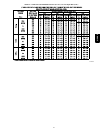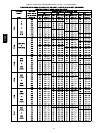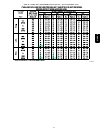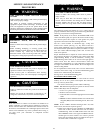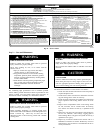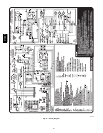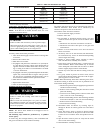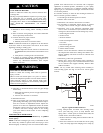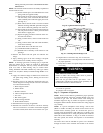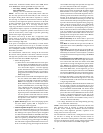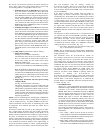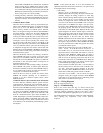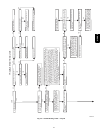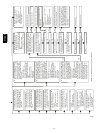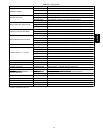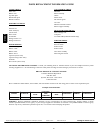
51
The start up and shut down functions and delays described in
item 1. above apply to the 2--stage heating mode as well, except
for switching from low-- to high--Heat and vice versa.
a. Switching from Low-- to High--Heat--If the thermostat
R--to-- W1 circuit is closed and the R--to--W2 circuit
closes, the furnace control CPU will switch the inducer
motorIDM speed from lowto high.The high--heatpres-
sure switch relay HPSR is de--energized to close the NC
contact. When sufficient pressure is available the high--
heat pressure switch HPS closes, and the high--heat gas
valve solenoid GV--HI is energized. The blower motor
BLWM will switch to HI HEAT speed five secondsafter
the R--to--W2 circuit closes.
b. Switching from High-- to Low--Heat--If the thermostat
R--to--W2circuitopens,andtheR--to--W1circuitremains
closed, the furnace control CPU will switch the inducer
motor IDM speed from high to low. The high--heatpres-
sure switch relay HPSR is energized to open the NC con-
tact and de--energize the high--heat gas valve solenoid
GV--HI. When the inducer motor IDM reduces pressure
sufficiently, the high--heat pressure switch HPS will
open. The gas valve solenoid GV--M will remain ener-
gized as long as the low--heat pressure switch LPS re-
mains closed. The blower motor BLWM will switch to
LO HEAT speed five seconds after the R--to--W2 circuit
opens.
3. Cooling Mode--The thermostat “calls for cooling.”
a. Single--Speed Cooling--
(See Fig. 27 for thermostat connections)
The thermostat closes the R--to--G--and--Y circuits. The
R--to-- Y circuit starts the outdoor unit, and the R--to--
G--and--Y/Y2 circuits start the furnace blower motor
BLWM on COOL speed.
The electronic air cleaner terminal EAC--1 is energized
with 115 vacwhen theblower motorBLWMisoperating.
When the thermostat is satisfied, the R--to--G and--Y cir-
cuits are opened. The outdoor unit willstop, and thefur-
naceblowermotorBLWMwillcontinueoperatingonthe
COOL speed for an additional90 seconds. JumperY/Y2
to DHUM to reduce the cooling off--delay to 5 seconds.
(See Fig. 24.)
b. Single--Stage Thermostat and Two--Speed Cooling
(Adaptive Mode)
(See Fig. 32 for thermostat connections)
This furnace can operate a two--speed cooling unit with
a single--stage thermostat because the furnace control
CPU includes a programmed adaptive sequence of con-
trolled operation, which selects low--cooling or high--
coolingoperation.Thisselectionisbasedupon thestored
history of the length of previous cooling period of the
single--stage thermostat.
NOTE: The air conditioning relay disable jumper ACRDJ must
be connected to enable the adaptive cooling mode in response to
a call for cooling. (See Fig. 33.) When ACRDJ is in place, the
furnace control CPU can turn on the air conditioning relay ACR
to energize the Y/Y2 terminal and switch the outdoor unit to
high--cooling.
The furnace control CPU can start up the cooling unit in either
low-- or high--cooling. If starting up in low--cooling, the furnace
control CPU determines the low--cooling on--time (from 0 to 20
minutes) which is permitted before switching to high--cooling. If
the power is interrupted, the stored history is erased and the
furnace control CPU will select low--cooling for up to 20 minutes
and then energize the air conditioning relay ACR to energize the
Y/Y2 terminal and switch the outdoor unit to high--cooling, as
long as the thermostat continues to call for cooling. Subsequent
selection is based on stored history of the thermostat cycle times.
The wall thermostat “calls for cooling”, closing the
R--to--G--and--Y circuits. The R--to--Y1 circuit starts the outdoor
unit on low--cooling speed, and the R--to--G--and--Y1 circuits
starts the furnace blower motor BLWM at low--cool speed (same
speed as LO HEAT).
If the furnace control CPU switches from low--cooling to
high--cooling, the furnace control CPU will energize the air
conditioning relay ACR. When the air conditioning relay ACR is
energized the R--to--Y1--and--Y2 circuits switch the outdoor unit
to high--cooling speed, and the R--to--G--and--Y1--and--Y/Y2
circuits switch the furnace blower motor BLWM to COOL speed.
NOTE: When transitioning from low--cooling to high--cooling
the outdoor unit compressor will shut down for 1 minute while
the BLWM continues to run at low--cool speed (same speed as
LO--HEAT) until the outdoor unit compressor comes back on at
high speed.
The electronic air cleaner terminal EAC--1 is energized with 115
vac whenever the blower motor BLWM is operating. When the
thermostat is satisfied, the R--to--G--and--Y circuit are opened.
The outdoor unit stops, and the furnace blower BLWM and
electronic air cleaner terminal EAC--1 will remain energized for
an additional 90 seconds. Jumper Y1 to DHUM to reduce the
cooling off--delay to 5 seconds. (See .Fig. 34.)
c. Two--Stage Thermostat and Two--Speed Cooling (See
Fig. 31 for thermostat connections)
NOTE: The air conditioning relay disable jumper ACRDJ must
be disconnected to allow thermostat control of the outdoor unit
staging. (See Fig. 33.)
The thermostat closes the R--to--G--and--Y1 circuits for
low--cooling or closes the R--to--G--and--Y1--and--Y2 circuits for
high--cooling. The R--to--Y1 circuit starts the outdoor unit on
low--cooling speed, and the R--to--G--and--Y1 circuit starts the
furnace blower motor BLWM on low--cool speed (same speed as
LO HEAT). The R--to--Y1--and--Y2 circuits start the outdoor unit
on high--cooling speed, and the R--to--G--and-- Y/Y2 circuits start
the furnace blower motor BLWM on COOL speed. The
electronic air cleaner terminal EAC--1 is energized with 115 vac
whenever the blower motor BLWM is operating. When the
thermostat is satisfied, the R--to--G--and--Y1 or
R--to--G--and--Y1--and--Y2 circuits are opened. The outdoor unit
stops, and the furnace blower BLWM and electronic air cleaner
terminal EAC--1 will remain energized for an additional 90
seconds. Jumper Y1 to DHUM to reduce the cooling off--delay to
5 seconds. (See Fig. 33.)
4. Thermidistat Mode
(See Fig. 26 -- 28 for Thermidistat connections) The dehu-
midification output, DHUM on the Thermidistat should be
connected to the furnace control thermostat terminal
DHUM. When there is a dehumidify demand, the DHUM
input is activated, which means 24 vac signal is removed
from the DHUM input terminal. In other words, the
DHUM input logic is reversed. The DHUM input is
turned ON when no dehumidify demand exists. Once 24
vac is detected by the furnace control on the DHUM input,
the furnace control operates in Thermidistat mode. If the
DHUM input is low for more than 48 hours, the furnace
control reverts back to non--Thermidistat mode.
The cooling operation described in item 3. above also ap-
plies to operation with a Thermidistat. The exceptions are
listed below:
a. Low cooling -- When the R--to--G--and--Y1 circuit is
closedandthereisademandfordehumidification,thefur-
naceblowermotorBLWMwillcontinuerunning atlow--
cool speed (same speed as LO HEAT).
b. High cooling --When the R--to--G--and--Y/Y2 circuit is
closedandthereisademandfordehumidification,thefur-
nace blower motor BLWM will drop the blower speed
312AAV



